Bioactive marine drugs and marine biomaterials for brain diseases
- PMID: 24798925
- PMCID: PMC4052305
- DOI: 10.3390/md12052539
Bioactive marine drugs and marine biomaterials for brain diseases
Abstract
Marine invertebrates produce a plethora of bioactive compounds, which serve as inspiration for marine biotechnology, particularly in drug discovery programs and biomaterials development. This review aims to summarize the potential of drugs derived from marine invertebrates in the field of neuroscience. Therefore, some examples of neuroprotective drugs and neurotoxins will be discussed. Their role in neuroscience research and development of new therapies targeting the central nervous system will be addressed, with particular focus on neuroinflammation and neurodegeneration. In addition, the neuronal growth promoted by marine drugs, as well as the recent advances in neural tissue engineering, will be highlighted.
Figures
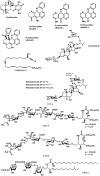
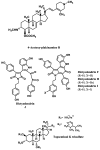

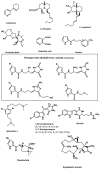
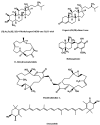
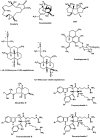
Similar articles
-
Marine-Inspired Drugs and Biomaterials in the Perspective of Pancreatic Cancer Therapies.Mar Drugs. 2022 Nov 1;20(11):689. doi: 10.3390/md20110689. Mar Drugs. 2022. PMID: 36355012 Free PMC article. Review.
-
Highlights of marine invertebrate-derived biosynthetic products: their biomedical potential and possible production by microbial associants.Bioorg Med Chem. 2011 Nov 15;19(22):6658-74. doi: 10.1016/j.bmc.2011.07.017. Epub 2011 Jul 26. Bioorg Med Chem. 2011. PMID: 21835627 Free PMC article. Review.
-
Bioactive Aliphatic Sulfates from Marine Invertebrates.Mar Drugs. 2019 Sep 9;17(9):527. doi: 10.3390/md17090527. Mar Drugs. 2019. PMID: 31505775 Free PMC article. Review.
-
Biomaterials and Bioactive Natural Products from Marine Invertebrates: From Basic Research to Innovative Applications.Mar Drugs. 2022 Mar 22;20(4):219. doi: 10.3390/md20040219. Mar Drugs. 2022. PMID: 35447892 Free PMC article. Review.
-
Exploring marine resources for bioactive compounds.Planta Med. 2014 Sep;80(14):1234-46. doi: 10.1055/s-0034-1383001. Epub 2014 Sep 9. Planta Med. 2014. PMID: 25203732 Review.
Cited by
-
Marine-Derived Compounds for the Potential Treatment of Glucocorticoid Resistance in Severe Asthma.Mar Drugs. 2021 Oct 20;19(11):586. doi: 10.3390/md19110586. Mar Drugs. 2021. PMID: 34822457 Free PMC article. Review.
-
Fiscalin Derivatives as Potential Neuroprotective Agents.Pharmaceutics. 2022 Jul 12;14(7):1456. doi: 10.3390/pharmaceutics14071456. Pharmaceutics. 2022. PMID: 35890350 Free PMC article.
-
Marine-derived protein kinase inhibitors for neuroinflammatory diseases.Biomed Eng Online. 2018 Apr 24;17(1):46. doi: 10.1186/s12938-018-0477-5. Biomed Eng Online. 2018. PMID: 29690896 Free PMC article. Review.
-
Characteristics of Marine Biomaterials and Their Applications in Biomedicine.Mar Drugs. 2022 May 31;20(6):372. doi: 10.3390/md20060372. Mar Drugs. 2022. PMID: 35736175 Free PMC article. Review.
-
Kororamides, Convolutamines, and Indole Derivatives as Possible Tau and Dual-Specificity Kinase Inhibitors for Alzheimer's Disease: A Computational Study.Mar Drugs. 2018 Oct 16;16(10):386. doi: 10.3390/md16100386. Mar Drugs. 2018. PMID: 30332805 Free PMC article.
References
-
- Mayer A.M.S., Rodríguez A.D., Berlinck R.G.S., Fusetani N. Marine pharmacology in 2007–8: Marine compounds with antibacterial, anticoagulant, antifungal, anti-inflammatory, antimalarial, antiprotozoal, antituberculosis, and antiviral activities; affecting the immune and nervous system, and other miscellaneous mechanisms of action. Comp. Biochem. Physiol. C Pharmacol. Toxicol. Endocrinol. 2011;153:191–222. doi: 10.1016/j.cbpc.2010.08.008. - DOI - PMC - PubMed
Publication types
MeSH terms
Substances
LinkOut - more resources
Full Text Sources
Other Literature Sources
Medical

